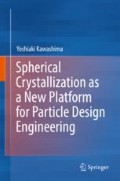Abstract
“Particle-design engineering” has emerged as a new engineering concept in modern powder technology. Since the early 1980s, micronized active pharmaceutical ingredient (API) powders composed of particles with diameters smaller than 5 μm and exhibiting poor water solubility or dispersible properties have been frequently formulated to improve the bioavailability of original API particles that are larger than around 50 to 100 μm, classified as Class 2 in the biopharmaceutical classification system (BCScriteria [1]. Specifically, fine particles, smaller than 1 μm in diameter, have very large surface energy and specific surface area, resulting in an increased solubility and activity of the original particles. However, it is difficult to disperse such fine particles uniformly in the finished product, due to the segregation caused by their strong cohesive properties. Such fine particle systems should be carefully handled according to the good manufacturing practice (GMP) introduced almost at the same time in the Japanese industry to guarantee the quality of finished products and a reliable manufacturing process. To ensure an optimum process and a suitable formulation for obtaining high-quality pharmaceutical preparations at the industrial scale, the division of Pharmaceutical Preparations and Particulate Design (PPD) [1] was established by the Society of Powder Technology of Japan in cooperation with the Association of Powder Process Industrial Engineering, Japan [2]. As an industry-oriented association, the New Pharmaceutical Technology and Engineering research institute (NPTE Inst.) [3] was first established in Japan in 2005, supported by Powrex Co. Japan. The mission of PPD is to create a new pharmaceutical process and innovative resulting products by paradigm shifting through a particle-design concept, defined as follows: “Particle design is to provide a new function to pharmaceutical preparations or to modify that of pharmaceutical preparations to create innovative medicine or medical device by designing physicochemical properties of particulate material as long as to reserve original chemical properties.” The physicochemical properties of particles are classified as intrinsic primary properties of discrete particles and integrated secondary properties of interacted particles (= powder) and their correlations, as listed in Table 1.1.
Access this chapter
Tax calculation will be finalised at checkout
Purchases are for personal use only
References
Amidon, G.L., Lennernäs, H., Shah, V.P., Crison, J.R.: A theoretical basis for a biopharmaceutic drug classification: the correlation of in vitro drug product dissolution and in vivo bioavailability. Pharm. Res. 12(3), 413–420. PMID 7617530 (1995, March)
Division of Particulate Design and Preparations, Society of Powder Technology, Japan. http://www.ppd-gifu.com/index.php
The Association of Powder Process Industry and Engineering Japan. http://www.appie.or.jp
New Pharmaceutical Technology and Engineering Research Institute. http://sinseizai.com/
Hersey, J.A.: Ordered mixing: a new concept in powder mixing practice. Powder Technol. 11, 41–44 (1975)
Sundell-Bredenberg, S., Nystrom, C.: The possibility of achieving an interactive mixture with high dose homogeneity containing an extremely low proportion of a micronised drug. Eur. J. Pharm. Sci. 12, 285–295 (2001)
Tee, S.K., Marriott, C., Zeng, X.M., et al.: The use of different sugars as fine and coarse carriers for aerosolised salbutamol sulphate. Int. J. Pharm. 208, 111–123 (2000)
Saharana, V.A., Kukkara, V., Katariaa, M., Kharbb, V., Choudhury, P.K.: Ordered mixing: mechanism, process and applications in pharmaceutical formulations. Asian J. Pharm. Sci. 3(6), 240–259 (2008)
Koishi, M., Ishizaka, T., Nakajima, T.: Preparation and surface properties of encapsulated powder pharmaceuticals. Appl. Biochem. Biotechnol. 10, 259–262 (1984)
Friedrich, H., Nada, A., Bodmeier, R.: Solid state and dissolution rate characterization of co-ground mixtures of nifedipine and hydrophilic carriers. Drug Dev. Ind. Pharm. 31(8), 719–728 (2005, Sep)
Nakai, Y.: Molecular behavior of medicinals in ground mixtures with microcrystalline cellulose and cyclodextrins. Drug Dev. Ind. Pharm. 12, 1017–1039 (1986)
Lonare, A., Patel, S.R.: Int. Chem. Eng. Appl. 4(5), 337–341 (2013)
Stock, D.I.: Micro-spherical aggregation of barium sulphate. Nature. 170, 423 (1952)
Author information
Authors and Affiliations
Rights and permissions
Copyright information
© 2019 Springer Nature Singapore Pte Ltd.
About this chapter
Cite this chapter
Kawashima, Y. (2019). Introduction. In: Spherical Crystallization as a New Platform for Particle Design Engineering. Springer, Singapore. https://doi.org/10.1007/978-981-13-6786-1_1
Download citation
DOI: https://doi.org/10.1007/978-981-13-6786-1_1
Published:
Publisher Name: Springer, Singapore
Print ISBN: 978-981-13-6785-4
Online ISBN: 978-981-13-6786-1
eBook Packages: Biomedical and Life SciencesBiomedical and Life Sciences (R0)

